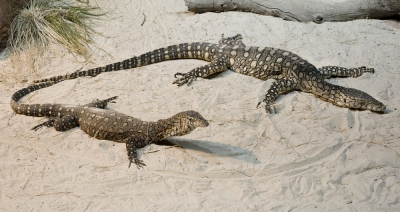
If you’ve ever visited the Sunshine State, you can’t miss them. No, we’re not talking about people in flipflops, we’re talking about alligators! They’re big, they’re exciting to watch, and they’re everywhere you look in the Everglades. In fact, as Floridians, we’re used to sharing our gorgeous state with them, and we respect the contribution they’ve made to our home. But what about crocodiles? There are distinct differences between alligators and crocodiles. If you’ve found yourself on an Everglades airboat tour and in a situation where you can’t tell if the animal in front of you is an alligator or a crocodile, here are a few tips to help you differentiate the two.
The Difference Between Alligators and Crocodiles
To most people, alligators and crocodiles look similar. While they do share many of the same features, they couldn’t be any more different to a trained professional. Typically, crocodiles are more aggressive than alligators, which makes crocodiles more dangerous than alligators. Alligators are opportunistic feeders, meaning that they’re not likely to chase you down unless they’re provoked. However, that certainly doesn’t mean that you should swim with them. Caution and common sense should be exercised at all times near and around both alligators and crocodiles on an Everglades excursion.
Physical Differences
The snout shape and jawline are probably the easiest ways to distinguish alligators vs. crocodiles on Miami airboat tours.
Snout Shape: Alligators have a wide, rounded, u-shaped snout, while crocodiles have long, pointed, v-shaped snouts. Believe it or not, the difference in shape means that alligators can exert more strength from their mouths, which is useful in cracking open hard-shelled vertebrates, like turtles.
Jawline: Alligators have a wide upper jaw, which allows for the teeth to remain hidden in the mouth. Crocodiles are different from alligators in this sense, where both the upper and lower jaws of a crocodile are the same size, exposing their teeth as they interlock, creating the look of a toothy grin. From a distance, it’s not too difficult to tell the difference between an alligator and a crocodile when looking at the shape of the snout and visibility of the teeth.
Size and Weight: Both alligators and crocodiles are massive reptiles. Gators can grow to be anywhere between 10 and 15 feet long as adults, weighing in at an average of 500 pounds. As far as crocs, they can reach an impressive 14 to 17 feet and can weigh as much as 2,200 pounds!
Skillset: Both gators and crocs can swim quite well, using their tail to maneuver through the water with ease. They can both also run about 11 miles per hour on land. When submerged in water, both reptiles can hold their breath for up to an hour. With eyes on the top of their heads, they’re tough to surprise. Both alligators and crocodiles are also excellent hunters after dark, as night vision is their forte.
Crocodylidae and Alligatoridae Families
The Crocodylidae family includes 15 species of “true” crocodiles, and the Alligatoridae family contains eight species of alligators and caimans.
Where Do Alligators and Crocodiles Live?
Water: These beautiful animals can be found all over the world – wherever slow-flowing rivers and grasslands dominate that you could see on an Everglades boat . Crocodiles tend to prefer salty waters, while alligators hang out in freshwater marshes.
Geographical Location: Alligators thrive in China and the southeastern portion of the United States, particularly Florida and the states along the Gulf Coast. Crocodiles are native to North, Central, and South America, Africa, Australia, and part of Asia. Interestingly, the Florida Everglades is the only place in the world where both alligators and crocodiles live together.
Meet the Alligators
Are you ready to come face to face with a living dinosaur? You can at Everglades Holiday Park! Our gator park is a premier destination for families, outdoor enthusiasts, and reptile aficionados alike. There’s no better place to experience exciting Everglades airboat tours, live alligator presentations, and Everglades animal encounters with the chance to pose with a baby alligator for a picture. Our park is South Florida’s best family fun locale for adventure.
As home to the Gator Boys Alligator Rescue, Everglades Holiday Park welcomes families, outdoor enthusiasts, and anyone interested in Everglades sightseeing and journeying through the ‘Glades in search of alligators, wading birds, fish, snakes, and more!
Credit : Everglades holiday park
Picture Credit : Google






